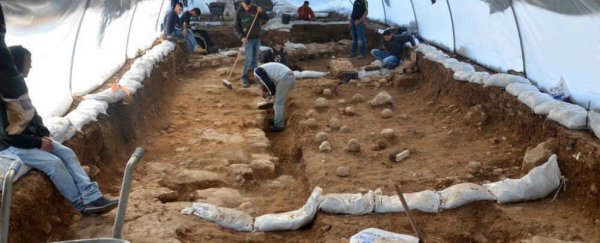A team of Israeli archaeologists have uncovered evidence of a Roman battlefield in Jerusalem that might have been left after the Roman emperor Titus sieged the city in 70 AD.
So far, the team has uncovered large ballista stones – projectiles used in a crossbow-type of weapon – and sling stones at the ancient Third Wall, which surrounded part of the ancient city of Judea more than 2,000 years ago.
"This is a fascinating testimony of the intensive bombardment by the Roman army, led by Titus, on their way to conquering the city and destroying the Second Temple," said excavation directors Rina Avner and Kfir Arbib, from the Israel Antiquities Authority.
"The bombardment was intended to attack the sentries guarding the wall and provide cover for the Roman forces so they could approach the wall with battering rams and thereby breach the city's defences."
The evidence was found during an archaeological dig last year, which was commissioned to clear the site for construction of the Bezalel Academy of Arts and Design.
When the team arrived, they found the remains of a tower that used to belong to Judea's Third Wall – a defensive structure that was built near the end of the region's Second Temple period, which ran from 530 BC to 70 AD.
According to written accounts of the battle by the historian Josephus, the team says the tower, called David's Citadel, and the Third Wall were constructed to protect a new addition to the city – a quarter called Beit Zeita, which lay outside the two other walls that protected the city's centre.
The team thinks the construction of the wall was first started by Agrippa I, who was King of Judea between 41 and 44 AD, though the project was halted by Roman Emperor Claudius, who was suspicious of him. And for good reason, it turned out.
At the time, Judea was a province of the Roman Empire, but the city had plans to revolt against Rome and gain independence.
"The construction of the Third Wall was resumed some two decades later by the defenders of Jerusalem, as part of fortifying the city and the Jewish rebels' preparations for the Great Revolt against Rome," the team explains.
Around 70 AD, the Great Revolt failed, and the Romans took Judea under the command of Titus. The newly found ballista and sling stones, the team suggests, are leftovers from that battle, which destroyed the Third Wall and Beit Zeita, leaving them abandoned and buried until now.
If the team can verify their findings, which are yet to be published, it could put an end a longstanding disagreement between archaeologists over where the Third Wall originally stood, and when it fell to the Romans.
"An unresolved debate among researchers has been going from the early 20th century up until the current excavation as to the identity of the Third Wall and the question concerning Jerusalem's boundaries on the eve of the Roman onslaught led by Titus," the team explains.
"It seems that the new discovery in the Russian Compound is proof of the wall's existence in this area."
The team will present their findings at the New Studies in the Archaeology of Jerusalem and its Region conference later this week, at the Hebrew University of Jerusalem.
